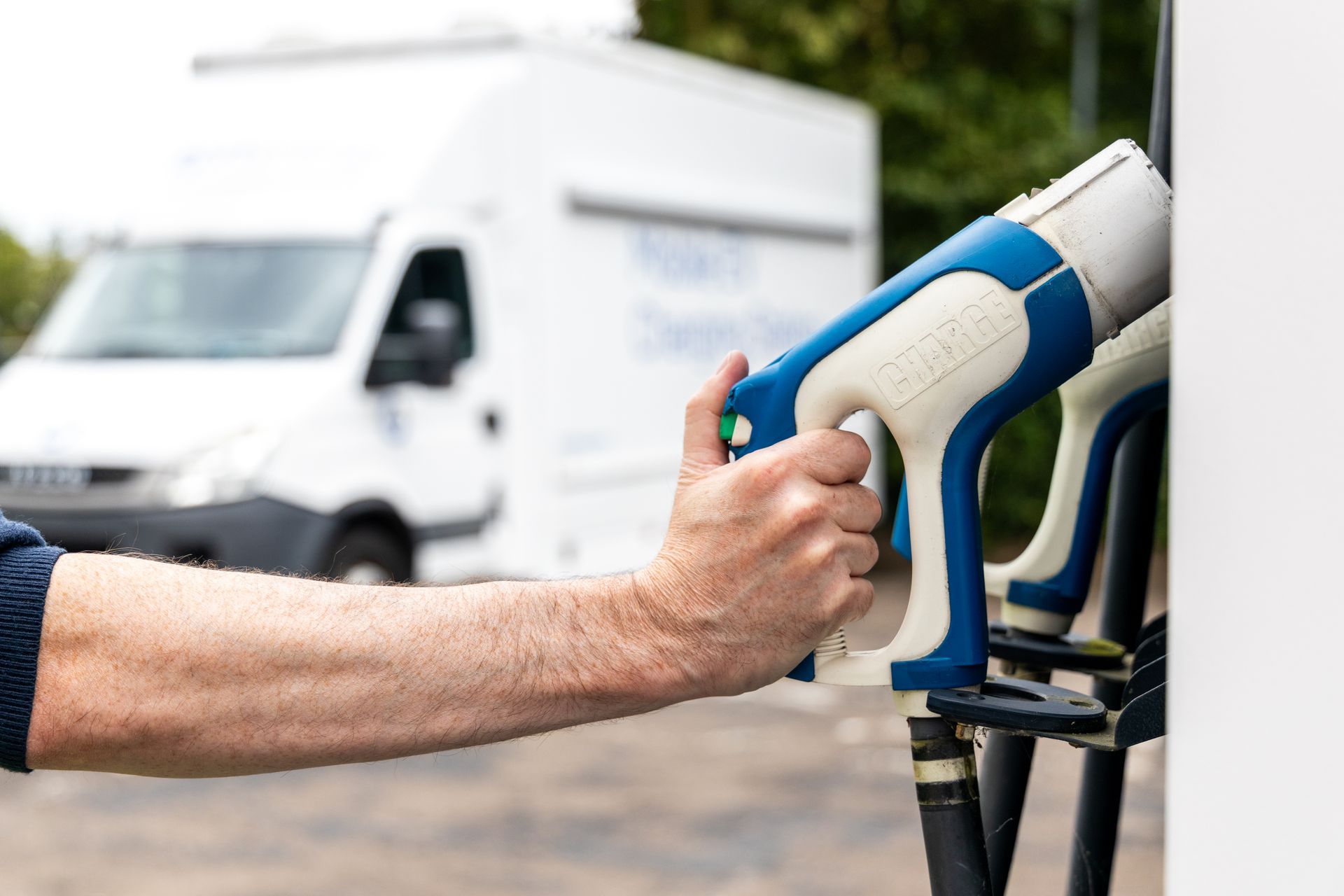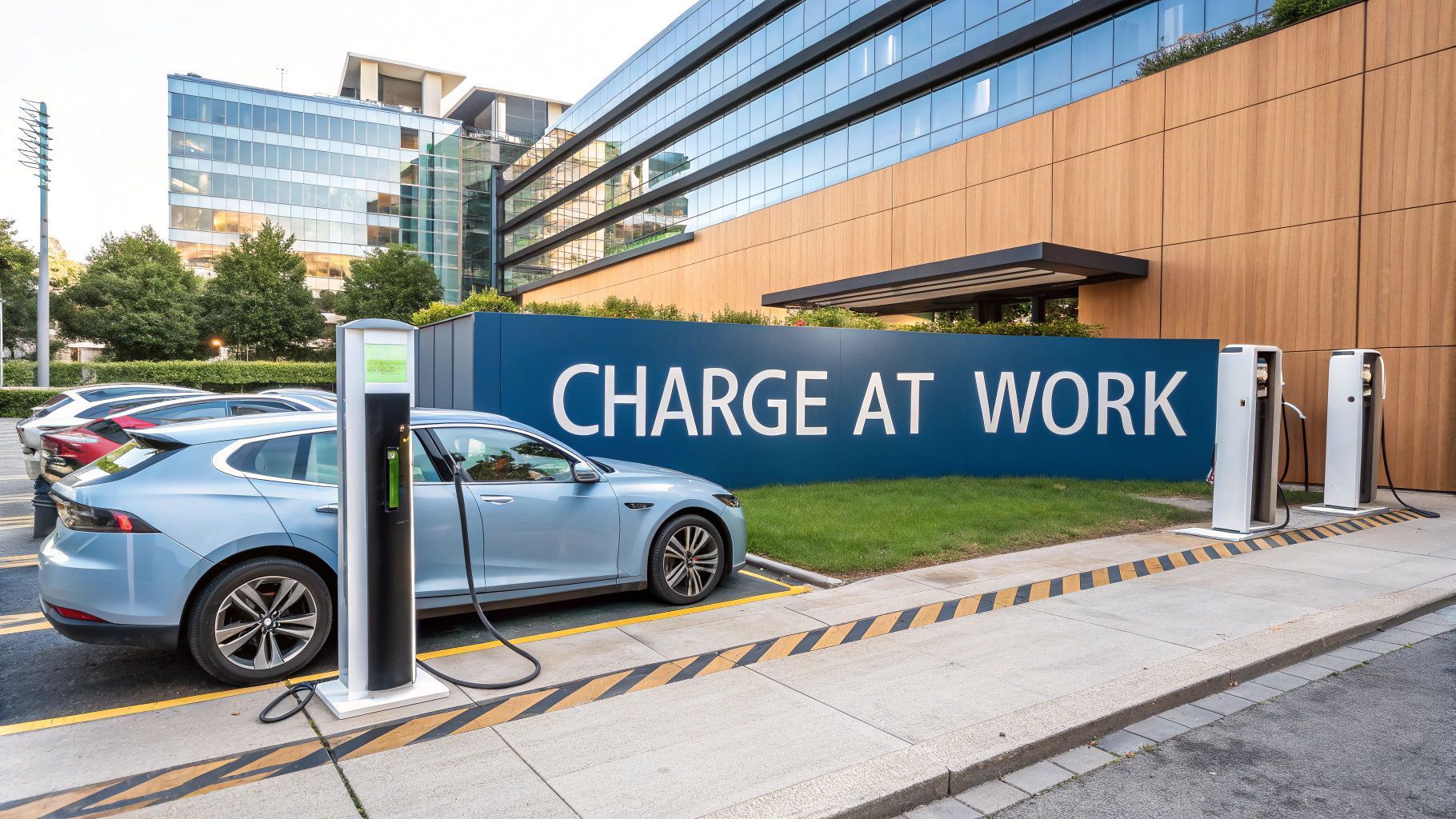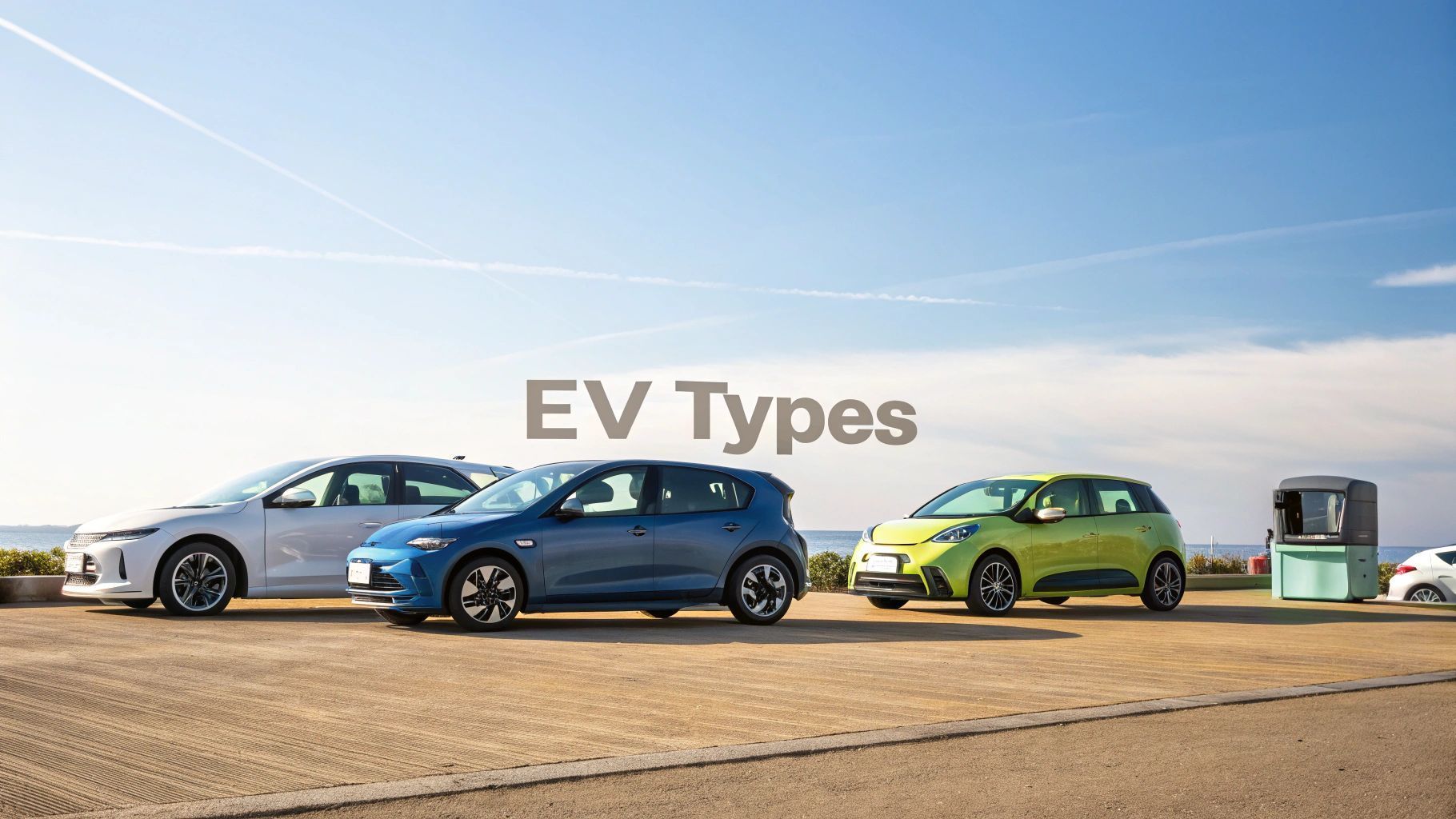Your Guide to EV Charging at Home in the UK
For most UK drivers, the answer to keeping an electric car topped up is simple: charge it at home . This is where you really unlock the convenience and cost savings of going electric, turning your driveway or garage into your own personal fuel station. It means waking up every morning to a full battery, ready for the day, without ever thinking about visiting a public charger.
Why Home Charging Is an EV Game Changer
Switching to an EV completely changes how you think about ‘fuelling’ your car. Forget those weekly trips to the petrol station. Instead, you get into a rhythm of "grazing" – topping up little and often, usually overnight while you’re asleep.
This small shift makes owning an electric car incredibly convenient for your day-to-day life. Having a dedicated chargepoint at home pretty much eliminates range anxiety for all your normal commutes, school runs and errands.
The financial upside is just as compelling. Powering your car from your home’s electricity supply is dramatically cheaper than relying on the public charging network. That cost difference alone is why home charging is seen as the gold standard for EV drivers.
The Real Cost Advantage
The savings really hit home when you look at energy tariffs. Charging at home gives you access to cheaper overnight electricity rates, something you’ll never find at a public chargepoint.
According to the Energy Saving Trust, charging an EV at home can cost as little as 10p per kWh on the right tariff. Compare that to the 50–70p per kWh you’ll often pay at a rapid public charger and the difference is huge. It’s this price gap that explains why well over half of UK battery electric vehicle (BEV) drivers say their car is cheaper to run than a petrol or diesel equivalent. You can find more expert insights on the UK's charging landscape at rolandberger.com.
Being able to charge at home is the single biggest factor in cutting the running costs of an electric car. It flips your mindset from actively hunting for fuel stations to passively refuelling while your car is parked anyway.
Overcoming the Hurdles
Of course, it’s important to be realistic. Home charging isn’t an option for everyone.
If you live in a flat, an apartment or a terraced house with no off-street parking, getting a private chargepoint installed is far from straightforward. This is a real challenge as it often leaves drivers facing the higher costs and hassle of relying entirely on the public network. Understanding this from the get-go will help you figure out if home charging is actually a viable option for you.
How to Choose the Right Home EV Charger
With so many brands and features on the market, picking the right home charger can feel a bit overwhelming. But it really boils down to matching the charger's capabilities to your car, your daily driving and your home's electrical setup. Get this right and you’ll have a convenient and cheap way to handle your ev charging at home .
The first big question is charging speed. In the UK, home chargers typically come in three flavours: 3kW , 7kW and 22kW . It’s tempting to think faster is always better but that isn't always necessary—or even possible for every home.
This decision tree gives you a quick visual on whether home charging is a realistic option based on where you live.

As you can see, having off-street parking like a private driveway makes installing a dedicated charge point much more straightforward.
Understanding Charger Speeds
Let’s break down what those power ratings actually mean for your daily life.
A slower 3kW charger is the most basic option and can feel painfully slow, sometimes taking over 24 hours for a full charge. For most people, a 7kW charger hits the sweet spot. It's the most common and practical choice for UK homes, giving you a full top-up overnight in around 8-10 hours.
Then you have the much faster 22kW chargers . They offer a serious speed boost but come with one huge catch: you need a three-phase electricity supply to run one. Most UK homes are on a single-phase supply, which means a 7kW unit is the most powerful you can install without a very expensive electrical upgrade. It's vital to get a professional to check what your property can handle before you buy anything.
To put it all into perspective, here's how the different speeds stack up for a typical 60kWh EV battery.
Home EV Charger Speed Comparison
| Charger Power | Approx. Charge Time (0-100%) | Best For |
|---|---|---|
| 3kW | 20-24 hours | Low-mileage drivers or plug-in hybrids with smaller batteries. |
| 7kW | 8-10 hours | The standard for most UK homes and fully electric vehicles; ideal for overnight charging. |
| 22kW | 3-4 hours | Homes with a three-phase electricity supply or drivers needing very fast top-ups. |
For the vast majority of EV owners, a 7kW charger provides more than enough power to wake up to a full battery every single morning.
The Power of Smart Charging
Beyond speed, the single most important feature to look for is smart charging . A smart charger connects to the internet, letting you control everything from a simple smartphone app. This is your ticket to unlocking some serious savings.
With a smart charger, you can schedule your car to only draw power during off-peak hours when electricity is at its cheapest. Many energy suppliers now offer EV-specific tariffs with incredibly low overnight rates—sometimes as little as 7.5p per kWh . Without a smart charger, you can’t tap into these deals and will be stuck paying the much higher standard daytime rate.
Smart charging does more than just save you money on your electricity bill. It also helps balance the demand on the national grid, making your home EV charging setup a small but important part of a more stable energy system.
Tethered vs Untethered Chargers
The final practical decision comes down to the cable: do you want it permanently attached or not?
-
Tethered Chargers have a cable fixed to the unit itself. This is convenience heaven—you just pull up, grab the handle and plug in. The only potential downside is making sure the connector is right for your current and any future cars you might own.
-
Untethered Chargers feature a universal socket, just like the ones you see at public charging stations. You use the portable cable that came with your EV to connect. This offers more flexibility and a tidier look on the wall but it does mean you have to get the cable out of your boot every time you charge.
For a deeper dive into the different features and models out there, check out this comprehensive guide to electric car home chargers.
And of course, making sure the charger you pick works perfectly with your vehicle is crucial. Our guide on EV charging compatibility can help you confirm the right connection type for your car before you make a decision.
What to Expect from the Installation Process
So, you're ready to get your own charger installed at home. Fantastic! This is one of those jobs where you absolutely need to call in the professionals. Unlike changing a lightbulb, installing an EV charging point means getting hands-on with your home’s high-voltage wiring. For obvious safety reasons—and legal ones—this is strictly a job for a qualified and certified electrician. The whole thing is a regulated process designed to keep you, your car and your property safe.

From your first phone call to the final safety checks, the entire procedure is probably more straightforward than you imagine. Your first move is to find a government-authorised installer. These are electricians with specific training for installing EV chargers, ensuring everything is done by the book and meets all current UK safety standards.
Finding a Qualified Installer
A great place to start is the government's OZEV (Office for Zero Emission Vehicles) approved installer list. Using an OZEV-approved installer isn't just a stamp of quality; it's also a must if you're hoping to apply for any available grants.
Once you’ve picked an installer, they'll carry out a pre-installation survey. This is a crucial step to make sure the job can be done safely and efficiently at your property.
Often, the survey is as simple as filling out an online form and uploading a few photos of your consumer unit (that’s your fuse box), your electricity meter and where you'd like the charger to go. For more complex setups, the electrician might need to pop round for a quick look in person.
During this survey, they're assessing a few key things:
- Your Home's Earthing: They need to check your property has the right electrical earthing arrangement. This is non-negotiable for safety.
- Consumer Unit Condition: The installer will have a look at your fuse box to see if there's enough space and capacity for the new circuit the charger will require.
- Cable Routing: They'll work out the safest and tidiest route for the cable to run from your consumer unit to the charger's spot on the wall.
Understanding Grants for Flats and Renters
While the main grant for homeowners with driveways has ended, the UK government still offers support to help people in different living situations switch to electric. The current scheme is aimed squarely at people living in flats or rental properties.
The EV chargepoint grant provides funding of up to 75% towards the cost of installing an electric vehicle smart chargepoint at domestic properties across the UK. It replaced the Electric Vehicle Homecharge Scheme (EVHS) on 1 April 2022.
To be eligible, you'll need to live in a rental property or own a flat and have your own dedicated off-street parking space. The good news is that both tenants and landlords can apply for this funding.
Usually, your chosen installer handles the grant application on your behalf and the discount is simply taken off your final bill. It’s a brilliant initiative that makes EV charging at home much more accessible for those who don't own a typical house, helping to close the gap in charging availability.
After the work is done, the installer will test everything thoroughly, give you a demo of how it works and hand over all the necessary safety certificates.
Breaking Down the Costs of Charging at Home
While charging your EV at home is almost always cheaper than using a public station, it’s worth getting your head around the full financial picture. You’ve got the initial, one-off cost to get everything set up, followed by the ongoing expense of the electricity you use day-to-day.
Think of it like buying a high-quality boiler or another major home appliance. The initial investment pays for itself over time through sheer convenience and the massive savings you’ll make compared to the alternatives—in this case, pricey public chargers or the petrol station.
The Upfront Investment
First up, there's the charger itself. For a good quality, smart 7kW charger—which is easily the most popular and practical choice for most UK homes—you can expect to pay anywhere from £500 to over £1,000 . The price tag really depends on the brand, the smart features you want and whether you go for a tethered model (with a fixed cable) or an untethered one.
Then you have the installation. This is absolutely not a DIY job; it needs a certified electrician to do it safely and correctly. A standard, straightforward installation usually costs between £400 and £600 . This covers fitting the unit to an exterior wall with a simple cable run to your consumer unit. If your electrics need an upgrade or the cable has to navigate a more complex route, this cost can creep up.
For a fully installed 7kW smart charger, a realistic budget is somewhere in the region of £900 to £1,600 . It's a one-time payment that unlocks years of cheap and incredibly convenient electric motoring.
Calculating Your Day-to-Day Running Costs
Once your charger is on the wall, your only ongoing cost is the electricity you put into your car. This is where you really start to see the financial upside of charging at home. How much it costs depends entirely on your home energy tariff, which is priced per kilowatt-hour (kWh).
To figure out the cost of a full charge, you just multiply your car's battery size (in kWh) by your electricity rate (in pence per kWh). If you want a deeper dive, you can learn more about how to calculate a kilowatt-hour in our detailed guide.
Let’s run through a quick, real-world example:
- Car Battery Size: 60kWh (a common size for a family EV)
- Standard Electricity Tariff: 25p per kWh
On this tariff, a full charge from empty would set you back £15.00 ( 60 kWh x £0.25). That’s already a big saving compared to a tank of petrol but the real magic happens when you get a bit smarter with your tariff.
Unlocking Huge Savings with Off-Peak Tariffs
This is the single most important financial tip for any EV owner. Many energy suppliers now offer special EV or Economy 7 tariffs with incredibly cheap electricity during off-peak hours—usually overnight, somewhere between midnight and 5 am. These rates can be as low as 7.5p per kWh .
Let’s do the maths again using an off-peak rate:
- Car Battery Size: 60kWh
- Off-Peak Electricity Tariff: 7.5p per kWh
Suddenly, that same full charge costs just £4.50 ( 60 kWh x £0.075).
By simply using your smart charger to schedule charging for these cheap hours, you slash your "fuelling" bill by an incredible 70% . This is how EV drivers achieve those headline-grabbing low running costs, often working out to just a few pence per mile.
Navigating Charging Without a Driveway
The dream of cheap, convenient EV charging at home is simple enough if you have a private driveway. But what about the millions of us living in flats or terraced houses?
For many urban drivers, this is a massive hurdle. It often means relying on a public charging network that can be expensive, inconsistent and frankly, a bit of a hassle.

This creates a clear 'charging divide'. While the UK's infrastructure is growing, there's a serious gap for city dwellers. Recent figures show that a staggering 25% of urban EV drivers don't have a home charger, a stark contrast to just 8% in the suburbs and 5% in rural areas.
Getting an on-street charging channel approved can cost around £3,000 and take over a year to get sorted and that's if your local council even allows them yet.
Exploring Creative Charging Solutions
Without dedicated off-street parking, you just have to think a bit differently. Your options generally fall into a few categories, each with its own pros and cons.
-
Relying on the Public Network: This is the default for most. It means using a mix of supermarket chargers, on-street posts and rapid charging hubs for top-ups. It’s doable but it demands more planning and almost always comes at a much higher cost per kWh.
-
Workplace Charging: If your employer offers EV charging, this is a brilliant substitute for a home unit. You can charge up during the workday—often for free or at a subsidised rate—which nicely mimics the overnight home charging routine.
-
Community Charging Schemes: Some innovative platforms are popping up that connect people who have a home charger with neighbours who need one. It’s a great way to share resources locally but availability can be hit-or-miss depending on where you live.
For many without a driveway, the biggest challenge isn't just cost. It's the mental load of constantly planning where and when to charge. This is a huge barrier to EV adoption in our cities.
Mobile Charging: A Powerful New Option
Thankfully, new solutions are appearing to tackle this exact problem. One of the most significant innovations is mobile EV charging . For those in larger buildings or business parks, mobile charging services are a genuine game-changer. These can be arranged by building management or fleet operators to provide on-demand charging, completely removing the need for costly and complex fixed installations.
This model not only benefits EV drivers by bringing the charger to them but it also opens up a compelling business opportunity. A mobile charging operator can service multiple vehicles at a single site, setting their own price per kWh. With the ability to buy electricity in bulk at commercial rates and charge a competitive consumer price, the potential profit margin is substantial. An operator with a single mobile unit could service an entire apartment block or business park, creating a consistent and profitable revenue stream. Our article on making EVs accessible for apartment dwellers dives deeper into how this works.
Right, let's clear up some of the common questions that pop up when you're thinking about getting a home EV charger.
Do I Need Planning Permission for an EV Charger?
For the vast majority of homes in the UK, the answer is no. Installing a home chargepoint usually falls under 'permitted development', which means you can go ahead without getting bogged down in paperwork.
There are a few exceptions, though. The rules typically state the unit can't be installed on a listed building, be within two metres of a public road or face directly onto it. If you live in a conservation area or a listed building, it's always worth a quick, informal chat with your local council first, just to be on the safe side.
Can I Just Use a Regular 3-Pin Plug Socket?
Technically, you can. You might have heard of a 'granny charger', which is essentially a special cable that lets you plug your EV into a standard wall socket. But honestly, this should be an emergency-only option.
Why? For starters, it is painfully slow. At a trickle of around 2.3kW , you could be waiting for more than 24 hours for a full charge. More importantly, it's a safety risk. Domestic sockets aren't designed to handle that much power for such a long, continuous period, which can lead to overheating and create a serious fire hazard.
A dedicated EV chargepoint isn’t just a convenience; it’s a critical safety feature for your home. It’s engineered specifically for the high, sustained power draw that an electric car needs, something a standard wall socket simply isn't built for.
How Much Does It Really Cost to Charge My EV?
This one's straightforward. The cost comes down to two simple things: the size of your car’s battery and what you pay for your electricity.
Let's run the numbers. Say you have a car with a 60kWh battery and your standard electricity rate is 25p per kWh . A full charge from empty would set you back £15 ( 60 x 0.25 ).
But here's the real game-changer: switching to an off-peak tariff. Many energy suppliers offer special overnight rates for EV owners. If your rate drops to just 7.5p per kWh , that exact same charge plummets to only £4.50 . This is where you see massive savings and it's precisely why a smart charger that can schedule your charging is an absolute must-have.
What Happens to the Charger If I Move House?
When it’s time to move, you’ve got a couple of practical options.
Many people choose to leave the charger behind. A professionally installed chargepoint is becoming a really attractive feature for home buyers and it can genuinely add a bit of value to your property.
The other option is to have a qualified electrician uninstall it and then reinstall it at your new place. Just remember to budget for both jobs—the removal and the new installation. You'll also need to make sure the wiring at your old property is made safe. Frankly, most people find it's simpler to leave the old one and get a fresh installation at their next home.
For businesses and property managers looking to provide flexible charging without the hassle of fixed installations, ZAPME offers pioneering mobile EV charging solutions. Our units deliver rapid charging on-demand, perfect for fleets, apartment buildings and commercial sites. Discover a simpler, more effective way to power your vehicles at https://www.zapme.biz.











